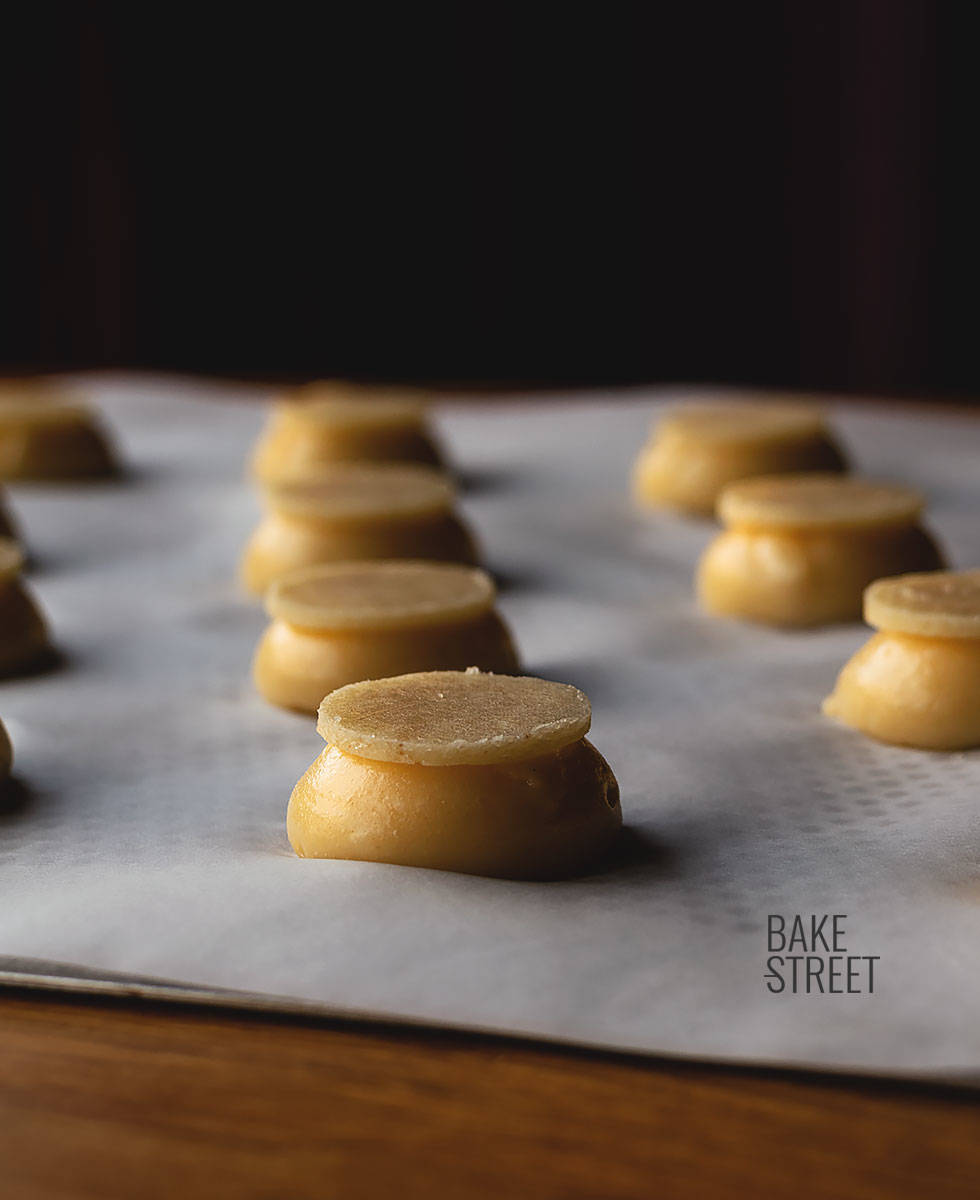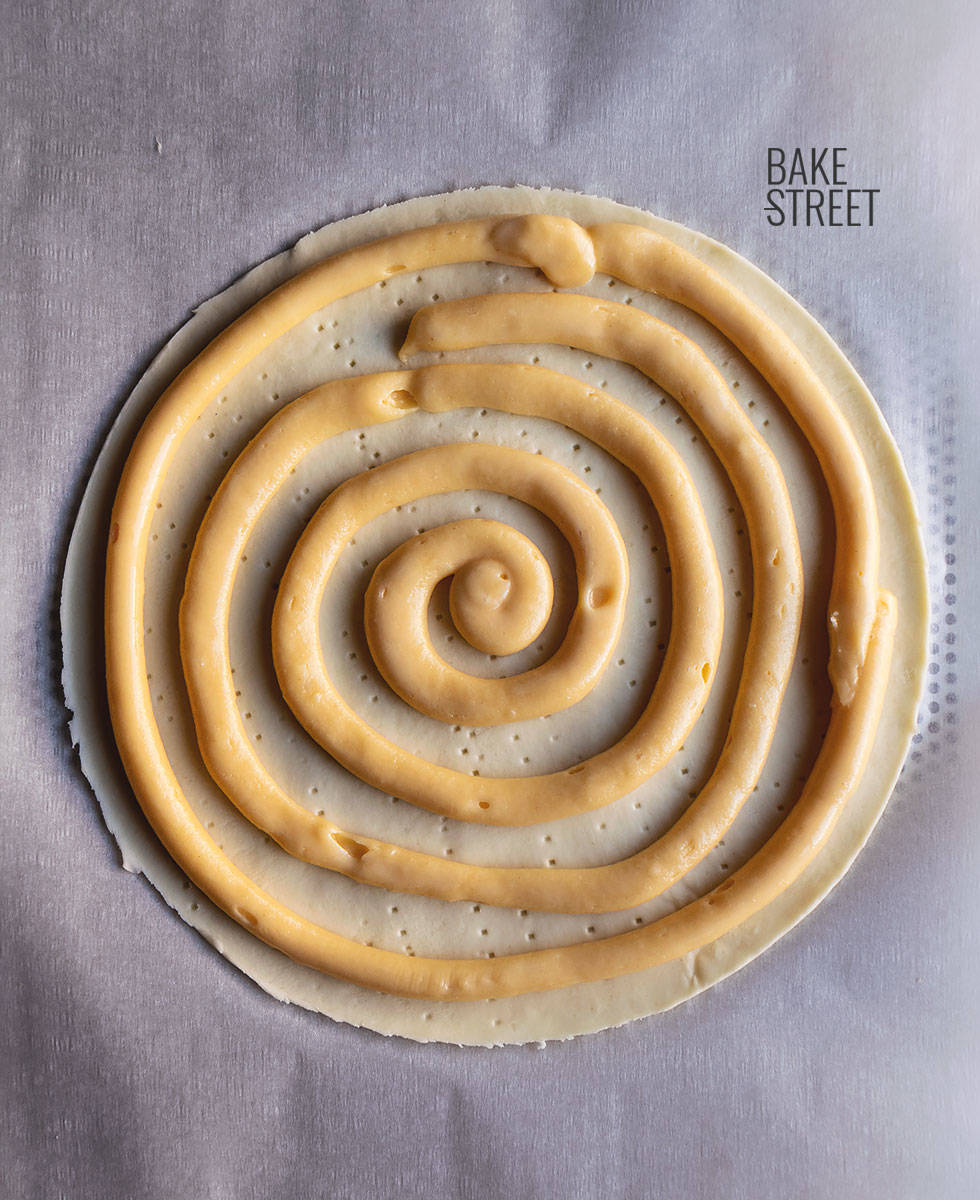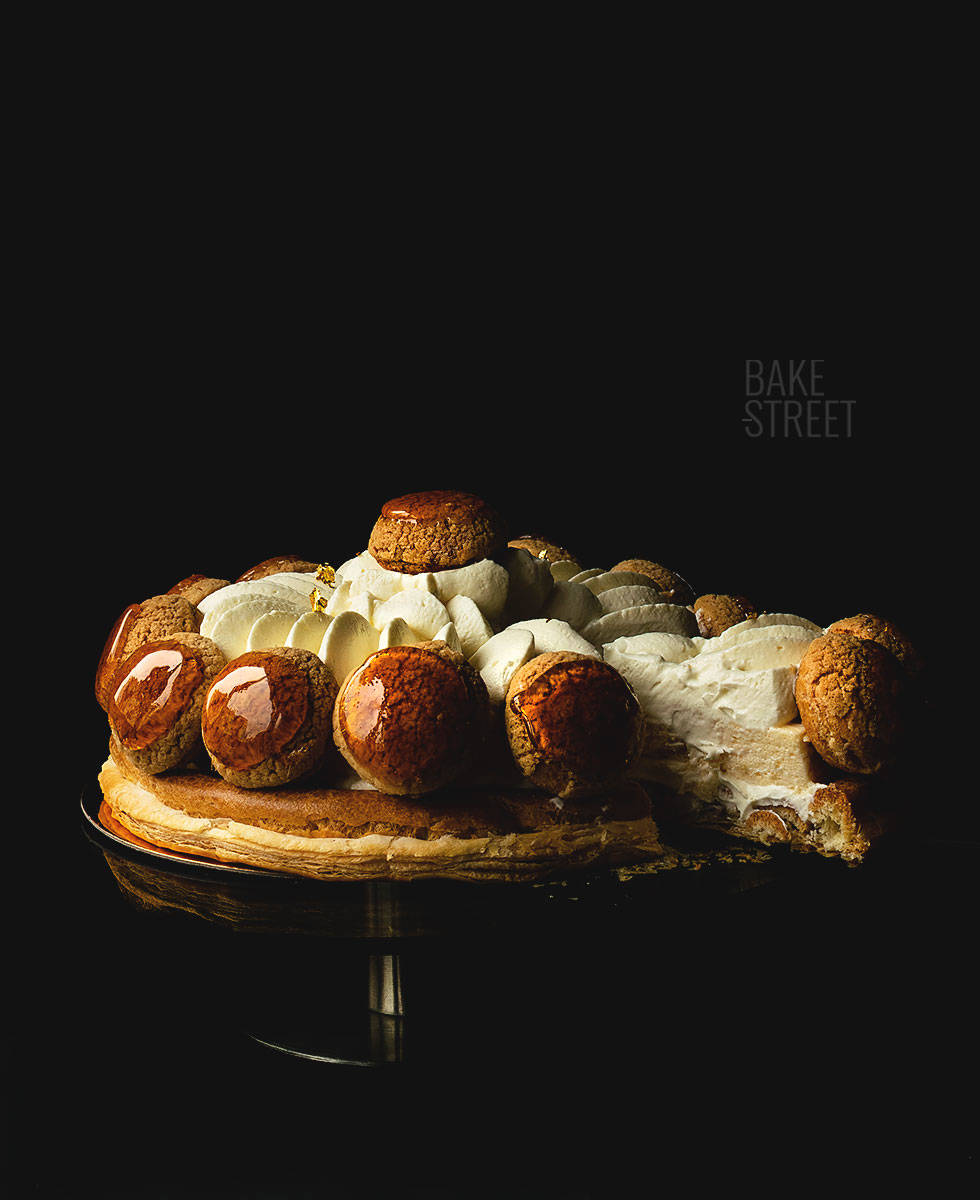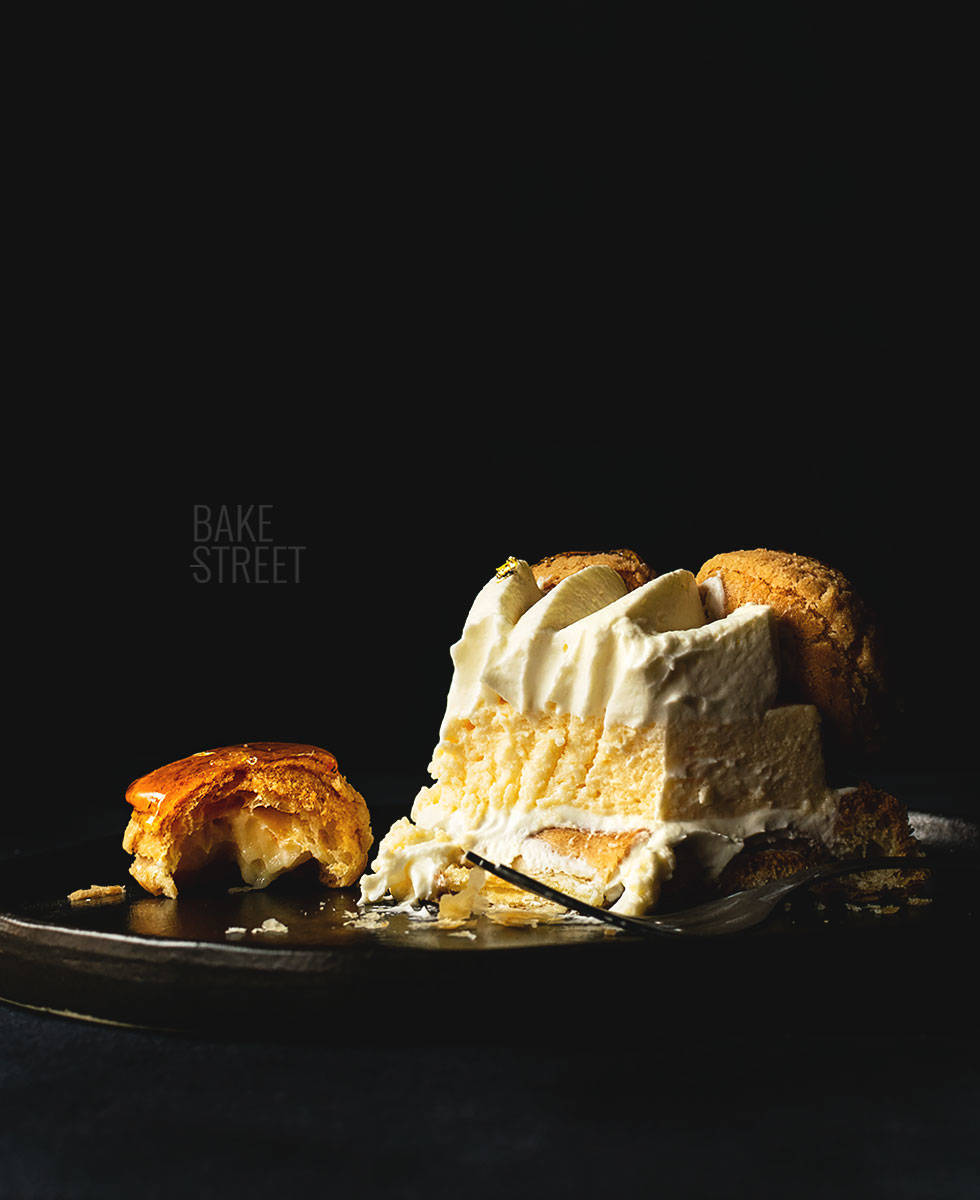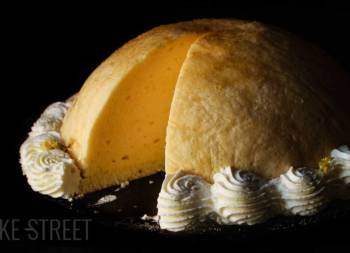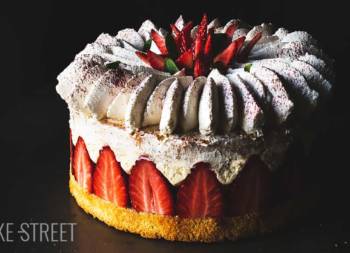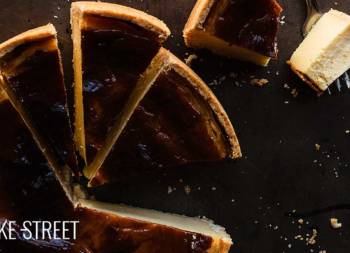
Tarte Saint Honoré
How come I haven’t shared this cake with you guys yet? It’s something I often ask myself when I finish making many of them. Today’s recipe is one of those preparations that I’ve been wanting to make for about 2 years. But, it’s never too late if happiness is good. Today we see how to elaborate the traditional and wonderful Tarte Saint Honoré.
Without a doubt a cake that assures you a resounding success, not only because of its presence, which I consider to be incredibly elegant. But also because of all the elements that make it up. A puff pastry base on which we piped a spiral of choux paste. On top of this, we place a cream of mascarpone and we place a Chiboust filling (cream made with pastry cream and Italian meringue). The final decoration consists of a cream of mascarpone accompanied with puffs covered with craquelin, a thin layer of caramel and stuffed with pastry cream.
There are no words that describe the sensation of tasting something like this. Only very intense emotions emerge, impossible to describe. Better to live them.
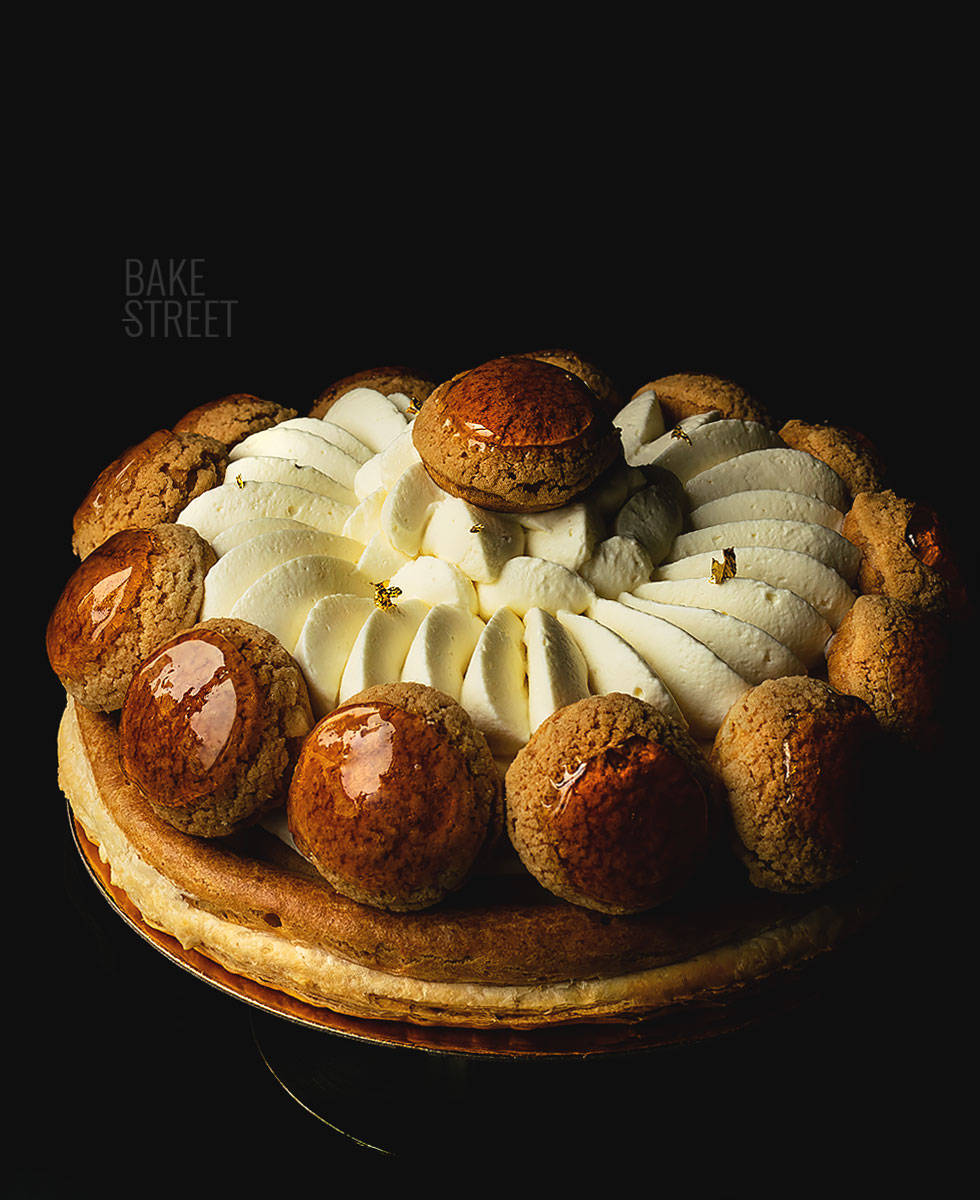
Tarte Saint Honoré origin.
This cake is one of the most representative elaborations of French gastronomy. It was created in honour of Saint Honorato, who was bishop of Amiens in the 6th century and is also the patron saint of bakers and confectioners.
The inventor of this famous cake was a pastry chef named Fauvel Chiboust, who had his business in Rue du Faubourg Saint-Honoré in Paris and who, in 1846, decided to create this preparation to honour the saint. The filling that makes this cake so special is Chiboust. Some time ago I left you a cake made with this filling, Lemon Souflée tart.
The reason Fauvel created this filling was to make it more consistent. Originally, this cake was made with a brioche dough and filled with pastry cream in winter and Chantilly cream in summer. This type of filling required the cakes to be filled as the orders arrived because after a couple of hours they softened.
So Fauvel created a cream made from a base of pastry cream and meringue, to which a little gelatine would also be added for added stability. It was a great success. Today, it is one of the best resources used in baking, as it can also be flavoured with different ingredients.
On the 16th of May of each year, the confectioner’s guild celebrates its onomastics with this creation of the famous Chiboust.
Who was San Honorato?
He was born in Port-le-Grand in Picardie, in the north of France at the beginning of the 6th century, son of a wealthy family from the region. From an early age he dreamed of becoming a bishop.
When he was very young, he was placed under the tutelage of the bishop of Amiens, Saint Béat. After the death of his spiritual father, in view of the zeal employed and his virtues, the clergy designated him as his successor, but as in his humble Christianity he rejected such an honour and a miracle arose: a celestial ray and a mysterious oil rested on his head, as a sign of the divine will.
Thus he was miraculously consecrated. He ran to tell his wet nurse that at that moment she was baking bread, before such a surreal story the old woman said “when the frogs breed hair” that in French became: “when my shovel grows the roots you will be bishop”.
“Oh” – said the woman – ” The shovel doesn’t go and it turns into a mulberry tree covered with leaves and flowers…”
Saint-Honoré was bishop of Amiens at a very young age, carrying out a strong evangelization during his mandate. He died on May 16, 600, in his native village where he was buried.
In 1202 a baker donated 9 arpents (acres) of land to build a chapel in his honor, thus becoming the patron saint of bakers.
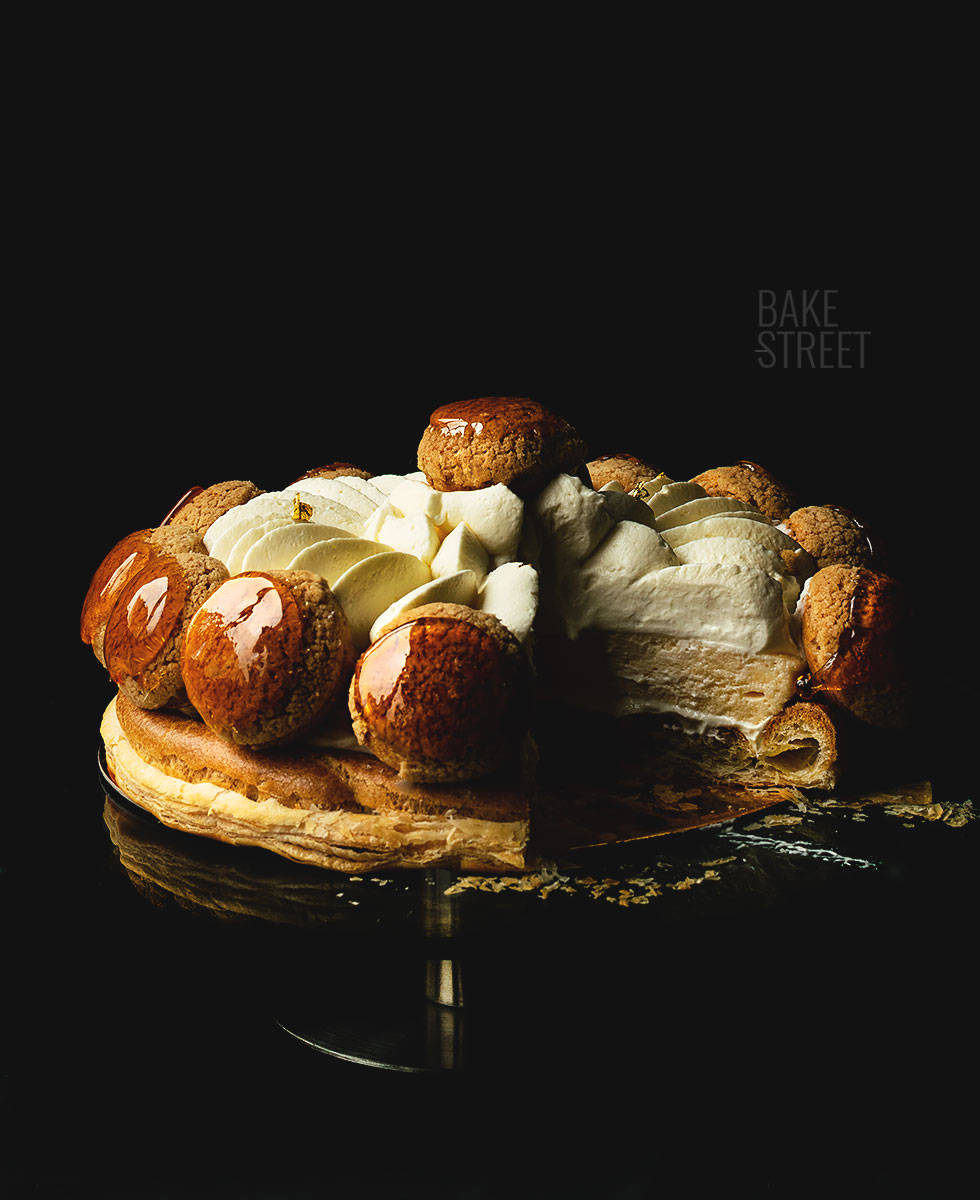
With time innovation came.
In 1863 the Julien brothers, also confectioners, “redesigned” the tarte Saint Honoré approaching the process that is known today. The cake was made from a base of pate sucrée or puff pastry surrounded by a crown and pâte à choux puffs. These were filled with the famous Chiboust cream, made from a pastry cream, Italian meringue (which provides a mousse-like texture) and gelatine to stabilise it.
Bad times.
At the end of 1880, news of poisoning caused by this cake appeared in the newspapers. It happened due to the lack of hygiene in the bakeries by not cleaning and removing the green parts of the copper containers without tinning, of the “mischievousness” of some confectioners by mixing the flour with plaster and some other barbarities of which the confectioner did not know.
The author of the chronicle “La cuisine des familles“, Albert Chevalier, cursed all those who wanted to enrich themselves at the expense of public health.
“According to us, if there were disappointments or anti-digestive surprises, it is that there was a defect in the preparation of the cake perhaps due to the use of counterfeit materials without the knowledge of the pie maker … “
It then lists some of the products that can be added to flour:
“Plaster, barite sulphate, rye grass, rye, etc. ”
“With a chocolate whose cocoa was replaced by mealy matters, they themselves vitiated, vanilla that only had the name left, sugar mixed with lime sulphate, milk made with starches and deteriorated brains, butter where you can find anything but cream, eggs bought very cheap to China having suffered a sea voyage of three months … “.
In the “Treatise on Modern Patisserie”, preceded by Phileas Gilbert, Saint Honoré’s recipe is given with extreme caution because:
“As a result of the poisoning observed on several occasions for a large number of people following the ingestion of this cake during the summer season, we consider it an imperative duty, given the seriousness of these food accidents, to involve our colleagues to exercise meticulous supervision over the cleaning of utensils … “
The chemists intervene and say the deaths are due to the egg white. All this is accompanied by a masterful two-page lecture on the correct and hygienic use of eggs and pastries.
The cause of these deaths was the egg, because the rest of the ingredients are cooked with the exception of the egg whites. It should also be added that these cakes were exposed in unrefrigerated display cabinets for a long period of time. Most cases of intoxication occurred in July and August.
Jeanne Savarin, the niece of the famous Chef Brillat Savarin, compiles in her book “La cuisine des Familles“, for the recipe of Saint-Honoré, a series of hygiene tips in the kitchen that revolve around this preparation.
Ingredients for a 8 inch cake
FOR PUFF PASTRY:
- 500 g flour W=300 (I have used Primitiva 300 Molino Pasini). You can use AP flour instead
- 230 g cold water
- 50 g sugar
- 20 g honey
- 35 g unsalted butter at room temperature
- 10 g salt
- 360 g cold butter for laminating
FOR CHOUX PASTRY:
- 125 g whole milk
- 125 g watera
- 140 g cake flour
- 115 g unsalted butter
- 5 g salt
- 1/2 tsp sugar
- 4 large eggs at room temperature
FORCRAQUELIN:
- 50 g plain flour
- 40 g unsalted butter
- 50 g sugar
FOR CARAMEL:
- 150 g sugar
- 50 g water
FOR CHIBOUST:
Pastry cream:
- 250 g whole milk
- 8 large egg yolks
- 30 g cornstarch
- 40 g sugar
- 4 gelatine sheets (8 g)
Meringue:
- 175 g sugar + 50 g water
- 175 g egg whites + 45 g sugar
FOR THE PASTRY CREAM:
- 250 g whole milk
- 1 tsp vanilla extract or a pod opened lengthwise
- 2 large eggyolks
- 60 g sugar
- 1 y 1/2 Tbsp flour (20 g)
- 1 y 1/2 Tbsp cornstarch (20 g)
FOR MASCARPONE CREAM:
- 250 g mascarpone cheese
- 250 g fat cream
- 65 g icing sugar
- 1 tsp vanilla extract
Instructions
FIRST DAY
Make puff pastry.
- To make this cake we will need about 200-250 g of puff pastry dough.
- We proceed to prepare the homemade puff pastry, for it we follow the process of elaboration that I left you in this post. It is explained step by step and accompanied by a video.
- If we prefer, we can use store-bought puff pastry (we will need 250 g dough) and, in this way, we will simplify the elaboration process a little.
Make craquelin.
- In a bowl add the flour together with butter and sugar.
- Mix with the help of a spatula until a homogeneous dough is obtained.
- Place between two sheets of Teflon and stretch with an adjustable roller, give a thickness of 2 mm.
- Store in the freezer for at least 1 hour.
- Take out the craquelin from the freezer, cut with a cutter of 1,2 inch/3 cm of diameter and put again in the freezer until the moment of its use.
Make choux pastry.
- Preheat the oven to 355ºF (180ºC).
- Sift the flour, set aside.
- In a saucepan, pour the water along with the milk, salt, sugar and butter. Place at medium heat and leave to boil.
- Once the mixture has boiled, remove from the heat and stir in the flour. Remove with a spoon/spatula at a fast and continuous speed.
- We'll get a ball of compact dough that we'll have to dry out. Replace at medium heat, stirring constantly.
- We will notice that the dough clings to the base, in total we leave it 2 minutes without stopping stirring. The degree of drying of the dough will depend on the quantity of eggs that it admits, we see it next.
- Transfer the dough to a large bowl and leave to cool lightly.
- Add the first egg and stir until it is homogenized, so that the dough can also take air and then influence what the dough can raise during cooking.
- Add the next egg and mix until completely combined. If the dough is too dry and does not have the right consistency, add a little more egg. In the notes I detail how to do it. The consistency should be as seen in the video and I'll explain in the notes.
Pipe and bake.
- Prepare the pastry bag with a 0,4 inch/1 cm diameter smooth tipe.
- Put the dough in a tray previously lined with baking paper, forming small piles of 1,2 inch.
- Moist your fingertips and lower the dough peaks.
- Place the craquelin discs on the choux paste and press gently.
- Place in the oven at medium height.
- After the first 15 minutes, let's observe that they are swelling up and we open the door of the oven so that the steam can escape for 3-4 seconds and we close them again leaving them 15-20 more minutes. They will take a golden color on the surface.
- Once the baking time is over, turn off the oven and let it stand inside with the door ajar for 5-10 minutes.
- Remove and let cool completely on a rack.

Bake puff pastry with paste choux.
- Preheat the oven to 355ºF (180ºC).
- Stretch the puff pastry and cut a disc of 8 inch/20 cm in diameter. Place on a perforated tray lined with baking paper.
- Prick the surface with a fork.
- Pipe a string of choux paste around the puff pastry leaving 0,2 inch/0.5 mm separated from the edge.
- Create a spiral of choux pastry inside the puff pastry leaving a little space between the cords of dough.
- Slightly moisten the choux dough and place in the oven at medium height.
- Bake for 30 minutes.
- Remove and let cool completely on a rack.

Make the pastry cream for the chiboust.
- Fill a bowl with very cold water and submerge the gelatine. Let it hydrate for 10 minutes.
- In a saucepan pour the milk, place at medium heat and leave until it comes to a gentle boil.
- On the other hand, in a bowl whisk the yolks together with the sugar and the cornstarch Mix well with a whisk.
- Once the milk has reached boiling point, pour a little (with the help of a strainer to prevent cream from seeping into the mixture of yolks).
- Whisk well to temper them and prevent lumps from forming.
- Pour the remaining milk and mix again.
- Pour the mixture into the saucepan and place at medium heat while stirring. You will notice that the texture will become denser.
- Cook until the cream has a creamy and slightly dense texture.
- Remove from the heat and add the hydrated gelatine. Remember that we must drain the gelatine very well so that we do not incorporate any water.
- Stir very well, and vigorously, with the whisk so that the gelatine dissolves and integrates completely.
- Set aside while we prepare the Italian meringue.
Make Italian merengue.
- In a medium saucepan pour the water together with the sugar and, without stirring, place at medium heat.
- Leave until it reaches a temperature of 250ºF (121ºC), the ideal would be to help us with a digital thermometer.
- While the syrup is cooking, whisk the egg whites together with the 45 g of sugar until obtaining a meringue that forms soft peaks.
- Once it reaches 250ºF (121ºC) remove from the heat and begin to integrate on the egg whites in a fine and continuous thread. We will do it at the same time that we beat the meringue to a medium speed. The final appearance will be a firm and very shiny meringue.
Prepare the chiboust.
- In a large bowl trasnfer the pastry cream, which must be warm, together with the freshly made Italian meringue. This one will still be hot.
- Add a small amount of meringue and mix with the help of a spatula. We will do it with soft and enveloping movements, never stirring or beating with a lot of energy. Otherwise the souflée will deflate.
- Keep adding more meringue and smoothly integrating into the chiboust until we've integrated everything.
- Set aside.
Put the chiboust in a pastry ring.
- Prepare a board with a sheet of Teflon on top.
- Place film on it and the pastry ring (mine is 9,45 inch/24 cm in diameter). Fold the ends of the film around the ring.
- Pour the chiboust into the ring. Extend and smooth the surface with the help of a spatula.
- Put it in the freezer until the next day.
Make pastry cream.
- Here you can see how to prepare the pastry cream.
- Once you have it ready, reserve it at room temperature until the moment of its use if you make the galettes the same day.
- In case you make it one day in advance, once it has cooled completely, place in the fridge until the next day.
SECOND DAY
Make mascarpone cream.
- Cream must be cold 24 hours before used it.
- The bowl in which we are going to make whipped cream must be cold. I recommend to use one aluminium bowl and freeze 20 minutes before beat it.
- Pour heavy cream along with mascarpone cheese into freeze bowl and beat with an electric mixer into low speed.
- Once cream is becoming to form stiff peaks, add sugar little by little stirring the whole time. Increase speed gradually but without reaches high one. Ideally use medium speed.
- Before finish to beat the cream, add vanilla extract and beat until get a perfect whipping cream. Be sure not to over-beat, otherwise cream will become lumpy and butter-like.
- Cover with plastic wrap and chill until used it.
Make the caramelo.
- In a medium saucepan, add the sugar along with the water. Place at medium heat.
- Let it begin to melt without stirring.
- Once it begins to caramelize, stir often to prevent some areas from burning. Reduce the heat a little if necessary.
- Remove the heat, sink the bottom of the saucepan in water to cut the cooking and proceed to bathe the puffs.
Cover the puffs with caramel.
- Submerge the puff trying to cover the top with craquelin.
- We will try to make the caramel layer as thin as possible.
- Place the puff in a silicone mould and let it cool completely.
- Repeat the same process with the rest of the pieces.
Assemble the cake.
- Put the pastry cream in a piping with a filling tip.
- Fill the puffs with the cream. Set aside.
- Place the mascarpone cream in a piping bag with a 0,7 inch/18 mm Saint Honoré tip.
- Pipe a little cream in the base.
- Remove the chiboust from the freezer and place on top of the cream. Press lightly. In my case, as the ring was larger than the desired size in height, I had to cut the dimension I needed (7 inch/18 cm) before placing it on the cake.
- Pipe the mascarpone cream by the surface of the chiboust.
- Decorate the edges with puffs.
- Place a puff in the central part of the cake. Decorate with edible gold.
- Serve.

Notes
- I know making puff pastry at home can be a long process. If you dare to do it, phenomenal. Otherwise, you can always use a store-bought sheet of puff pastry.
- To decorate the cake we will need 14 puffs. With the quantity that I leave you in the elaboration you will be able to squish the base, the 14 units and a few more. In my case came 30 pieces more of a slightly larger size than the cake. You can fill them with chiboust, cream... And keep them refrigerated for 2-4 days, depending on the filling you have chosen.
- The amount of pastry cream I leave you is the right amount to fill the puffs of the cake. If you want to fill them all, you must make more.

- Puffs get bigger with craquelin on the surface. I piped some to which I did not place craquelin and grew much less in the oven. You can see the difference in size in the video (on the tray after baking).
- If you don't want to get leftovers chiboust, my family likes it a lot and they don't mind eating it as it is, you should reduce the amount of ingredients in half.
- Another option may be to use that surplus to fill the puffs instead of the pastry cream. Or fill the surplus puffs with it.
- You might wonder why I haven't used the 18 cm diameter ring directly. The reason is that I wanted to give the height that has the ring of 24 cm and I did not know if filling the ring of 18 cm, I was going to get the one I wanted.
- The top cream is made with mascarpone and cream. The final texture is very creamy and denser than if we do it only with cream. It also has a mild and wonderful taste. In case you don't like the cheese, you can omit it and decorate the surface only with whipped cream.
- There are many options for piping mascarpone cream. In my case I have shown you the most classic, I find it very elegant. But there is a great infinity of them, all wonderful, that you can carry out to decorate the cake.
- When we cover the puffs with caramel, be very careful not to burn yourselves. Typically, after bathing the caramel surface, they are placed upside down in a silpat or silicone mold with holes. In this way we achieve a perfectly rounded finish in the second or a flat finish in the first. My intention was to use a silicone mould that I have, but the profiteroles grew a little more than expected and did not fit ... I don't like the way they look with the flat surface, so I chose to do it as I show you in the video. I comment the two options so that you can keep them in mind and choose your choice.
- It can be kept refrigerated for 2-3 days.

I always tell you the same thing, but you have to try this Tarte Saint Honoré, hahaha. Really, there are elaborations that you have to try at least once in your life. And if you can do them, too. I think that if you like to cook, doing this type of preparation will give you a lot of satisfaction.
It has come to a point in my life that I do not conceive the fact that the days pass and not try to do new things referred to the world of gastronomy. For me it has become a lifestyle in which I find my happiness and well-being.
Now, do it! Do not deprive yourselves or your family of this wonder ;)
I wish you a wonderful weekend, see you on Monday!
Big hugs,
Eva
Sources: Alsace Nouvelle Gastronomiques,À la bonnee franquette con Michelle
